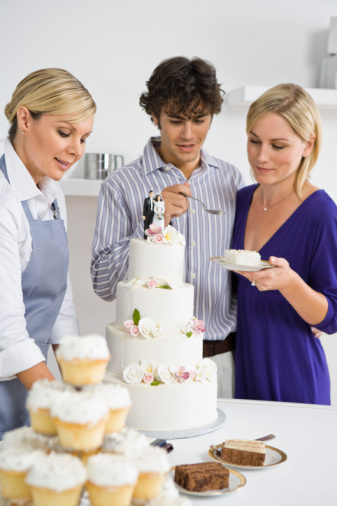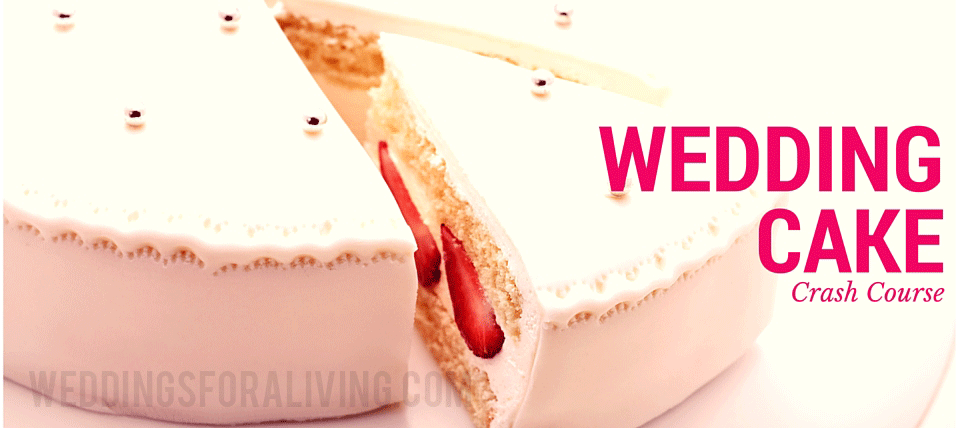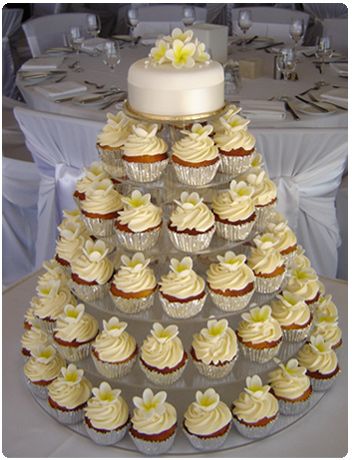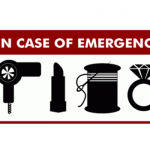This episode is an information-packed audio class primarily for the new (but could certainly help even the more experienced) professional, wedding planner and it’s all about wedding cakes. Yum!
What could be more symbolic of a wedding than a wedding cake? So special that it gets its very own, spot-lit table, a wedding cake will be photographed, cut, and oftentimes kept as a special keepsake for what is a very special day.
For centuries weddings have been celebrated with a special cake. And they have evolved drastically!
The ancient Romans would finalize their wedding ceremonies by breaking loaves of wheat bread over the heads of the newlyweds to bring luck and prosperity.
In medieval Europe [5th century – 15th century AD], the bride and groom would attempt to kiss over a super-tall stack of spiced buns. If they were successful, a prosperous future was almost certainly guaranteed!
Between the 17th and 19th century in England, Bride’s pie was an important wedding dish which eventually evolved into bride cake—the forerunner of the modern-day wedding cake.
The multi-tiered wedding cake, as we know it today, has it origins in a creation for the wedding of Queen Victoria’s daughter Vicky, in 1858 (although only the bottom tier was actual cake). The first tiered wedding cake made entirely of cake was made for Prince Leopold’s wedding in 1882.
Because most Victorian bakers lacked the skill to stop the top layer of a wedding cake from becoming the bottom layer it took 20 more years before columns were used to separate the cake layers.
Wedding Cakes Today
Today, the wedding cake takes center stage at the wedding reception and will be forever immortalized in photos. It can be one tier or seven! Cakes can be sleek and modern if that’s your client’s preference. Or maybe a lavishly ornamented cake more closely resembles the style they have in mind.
In some instances, the wedding cake doesn’t even look like a cake at all!
Tiered Wedding Cakes
Visit any wedding planning website or blog and you’ll see picture after picture of multi-tiered wedding cakes. A multi-layered cake has to be carefully constructed and reinforced internally to prevent the top layers from collapsing on to the bottom layers. (Which is why it’s so important to entrust this task to an experienced professional!). For support, dowels are inserted into each layer of cake in addition to foam or cardboard inserted underneath each layer.
For adventurous couples who want to inject a sense of fun into their wedding, a topsy-turvy cake is a whimsical favorite. Wedding guests always get a kick out of a crooked cake. And just so you know, the cake isn’t really crooked, it’s just constructed to look that way.
Other Types of Wedding Cakes
Cupcakes are another trend at weddings. This stylish alternative is a personal favorite; however, don’t assume that these individual morsels will cost less than a traditional tiered wedding cake. Creating cupcakes is a labor-intensive process.
In the UK, the traditional British wedding cake is a fruitcake covered with marzipan. Inside, the cake is made with fruits, prunes and raisins soaked in brandy or whiskey. The top tier is saved as the ‘christening cake’ for the couple’s first baby.
In France the magnificent ‘croquembouche’ [kroh-kuhm-BOOSH] is a truly unique wedding cake. A cone-shaped tower (sometimes more than 5-feet high) of profiteroles (cream or custard-filled cream puffs) are stuck together with caramel and covered with spun sugar. The croquembouche evolved during the time of King Charles II and was quite the status symbol since sugar, at the time, was a rare commodity.
Wedding Cake Frosting & Fillings
Wedding Cake Frosting or Icing
Your clients have several options for the type of icing for their wedding cake. In the US fondant and buttercream are most frequently-seen.
Fondant
Fondant is the “secret sauce” of picture-perfect cakes. Made of sugar, corn syrup and gelatin, fondant has the consistency of play dough and is rolled out like a pie crust and draped over the cake giving it a porcelain-like, smooth finish. Perfect for hot, humid weather it won’t melt and actually keeps the wedding cake fresh for a couple of days at room temperature.
A downside that you should share with your bridal clients, who have their hearts set on a fondant-decorated cake, is that the taste is just so-so and not very pleasing to everyone’s palate. Using butter cream (which we’ll talk about in just a moment) underneath the fondant is a baker’s trick sometimes used to improve the taste. Fondant cannot be refrigerated. If it is, water spots are formed from condensation.
Butter Cream or Buttercream
Buttercream, as the name suggests, consists of butter and sugar. Not only does this fluffy icing have a pleasant, buttery-sweet flavor, it’s easy to color, easy to flavor, and is less labor-intensive to make than fondant. As a result it’s a less-expensive option for a wedding cake (keep this in mind when working with budget-conscious clients).
Buttercream is used for frosting or icing the outside of the cake and for the cake fillings, inside. Because of its high butter content, butter cream won’t last long in very warm environments, so if your clients are planning an outdoor wedding during the height of summer, butter cream icing is not the way to go.
Here are a few more wedding cake icing terms you should familiarize yourself with:
Royal Icing
Although not as popular in the US as fondant or buttercream, royal icing is made of confectioner’s sugar and egg whites. This meringue-like, sweet icing is pure white and dries very hard very quickly and doesn’t need refrigeration. Royal icing is piped using a pastry bag and is a favorite for creating delicate flowers and intricate wedding cake designs.
Marzipan
Used by pastry chefs for centuries, marzipan is an edible modeling clay with a sweet, almondy taste that’s popular in Europe. Made from sugar, eggs and crushed almonds, marzipan has a light golden color and is rolled into thin sheets (like fondant) and placed over a cake before it is iced. Marzipan is also hand-shaped into fruits and other edible sculptures.
Whipped Cream
Whipped cream is an inexpensive icing and/or filing for a wedding cake. Not as sweet as butter cream, whipped cream must be refrigerated until the last possible moment and is the perfect complement (and a personal favorite) for wedding cakes that have sweet, fruit fillings.
Dragées (pronounced ‘dra-ZHAY’)
Dragees are small, edible, candied beads or balls coated with metallic gold or silver used to decorate cakes.
Chocolate Ganache (pronounced ‘guh-NAWSH’)
Ganache is a smooth mixture of chocolate melted with heavy cream. This chocolate lover’s dream is poured over cakes to create a beautiful, glossy finish. Chilled ganache is used to make chocolate truffles.
Gum Paste or Pastillage (pronounced ‘PAHS-tee-AHJ’)
Gum paste is a sugar-based dough that dries to a very hard and rigid texture and is molded to make edible decorations, especially botanically correct flowers.
Wedding Cake Fillings
Most professional bakers offer wedding cake in a variety of flavors with delicious fillings. Many of your clients will chose either yellow or white cake. But, there’s also a good chance that the meeting with the cake maker will introduce your clients to a long, long list of other wedding cake flavor options to consider.
For a multi-tiered cake your clients can stick with just one favorite flavor or mix things up and use a variety of cake flavors for each of the different tiers.
Wedding Cake Pricing
Most bakers and pastry chefs charge for wedding cakes by the slice.
Depending on your location, prices may vary from $2.00 a slice (a standard cake made from a mix) to $20 (a custom design, baked from scratch) for each slice.
So, for example if the price for a wedding cake is listed as $4.00 per slice, a cake for 150 wedding guests would cost $600 ($4 X 150 people).
The final wedding cake cost is determined by the labor involved in creating the masterpiece. Most bakers will have a base price that consists of just cake and butter cream. From there, each upgrade adds to the price—marzipan fruits, sugary flowers, etc. Of course, as a professional wedding planner, once you know what drives the cost of the wedding cake, you can help to keep your client’s costs down.
Working with the Cake Maker
 Secure the wedding cake maker four to six months before your client’s wedding. As a professional wedding planner, complete your research before you recommend a cake maker to your clients. You need to:
Secure the wedding cake maker four to six months before your client’s wedding. As a professional wedding planner, complete your research before you recommend a cake maker to your clients. You need to:
• Make sure s/he meets local health requirements and operates out of a clean and sanitary location.
• Find out if cakes are priced by the slice (most bakers price this way). If not ask how prices are established.
• Determine if the baker will deliver the cake and set it up
• Make sure s/he has wonderful references—check ‘em! Ask other vendors if they’ve worked with this person and check out their list of clients
• Ask if all flavors and fillings cost the same
• Ask about back-up plans (in the event something happens)
When you finally get to meet a professional cake maker, ask to see a portfolio of cakes. Also, try to find bakers who routinely use fresh ingredients—real butter and cream, fresh fruit…the cake should taste just as good as it looks.
Keep in mind that many local grocery stores can create beautiful wedding cakes that cost far less than a traditional wedding cake maker. Don’t discredit places such as Costco, Sam’s Club for wedding cakes.
Once you’ve completed your homework, to ensure that your clients receive the undivided attention of this professional when they meet with him or her, make an appointment first.
Be prepared to have some basic information ready for the cake maker:
• Wedding date
• Reception location (address)
• Number of guests expected
• Number of servings (get for 75%)
• Wedding colors, design
• Any pictures or sketches of cakes
Although I suggest hiring a professional cake maker months before the big day, when it comes to the actual design of the wedding cake, for a cohesive look, it makes sense to do this after wedding colors, wedding gown, and the overall style of the wedding are selected. After all, you don’t want the cake to look like it was delivered to the wrong party! If the reception is in a clean, modern room, the cake should follow suit. If your clients are getting married on the beach, a cake with sugar seashells and colors that resemble sand and water might be the way to go.
Some other information that you may not have thought of that I have found to be helpful during the cake design process include:
• The size of the room where the cake will be displayed
• The ceiling height of the room where the cake will be displayed
• What time of day the meal is being served
• What the weather will be like – an outdoor reception on a warm humid evening is not the occasion for a multi-tiered butter cream confection
• How formal the wedding is
• Whether or not the wedding cake will serve as the only dessert
Just like any other wedding vendor that your client hires, the cake maker should have a contract in place……
Once your clients have selected their cake maker, the best way for them to make up their minds about the details of the wedding cake is with a cake tasting session.
When your clients go for a tasting, suggest that they try all the filings and then write down the ones that they like.
Wedding Cake Delivery & Set-Up
Check the baker’s delivery fee; some are standard others charge by mile. Check to see if the reception site is within the baker’s radius. In my experience, delivery is usually included in the quoted cake price.
Moving a wedding cake is a job for professionals (in the cake business) only!
As the professional wedding planner, you need to let the cake maker know about any stairs at the reception site and also how close to the site the delivery vehicle can park. Ideally, the cake maker should deliver the cake to the exact spot where it will be displayed. This means having the cake table positioned and covered with any necessary linens before delivery. Inexperienced people trying to move a wedding cake spells disaster!
Wedding Cake Table Set-Up
As you work through the creation of your client’s wedding day schedule, arrange to have the cake set up no more than two hours prior to reception. An unattended cake can be disastrous!
Think through exactly where the cake table will be located. The banquet manager or staff will likely offer suggestions. Keep in mind:
• Positioning the cake table in front of mirror is a photographer’s nightmare
• Positioning the cake table in a corner makes it difficult for guests to see the bride and groom cutting the cake, especially for photos
The table that displays the cake, usually a 30-inch round, should be decorated beautifully. Use the same or complementary linens as on the guest dining tables. The tablecloth should reach the floor as that looks the elegant. Patterned fabrics are tricky and have the potential to overpower the cake. Layering cloths and pinning up sections is a look that works wonderfully. Check with the caterer for other creative and brilliant linen and décor suggestions.
Scatter real or silk petals over tablecloth and around the cake and like any focal point in the room make sure the cake table is well lit. Don’t forget to place a small plate, the cake-cutting knife and two forks on the table for the actual cake cutting ceremony…speaking of which…
“It’s Time to Cut the Cake!”
Usually the first task together as newlyweds is to cut the wedding cake. Many guests wouldn’t dream of leaving the wedding reception until the cake is cut, so encourage your clients not to wait until the very end of the reception to do so.
Don’t forget to determine what musical selection should be playing for this much-anticipated portion of the wedding reception. Your DJ or band leader may have some suggestions for you. Otherwise, an encore of the couple’s ‘first dance’ song is always a good choice.
Traditionally the couple feed each other the very first pieces of their wedding cake. As the wedding planner, be prepared to give them a quick rundown of what the cake cutting actually involves:
1. The bride picks up the knife
2. The groom places his right hand over hers
3. Together, using the point of the knife, they make two cuts in the back of the bottom layer of cake and then remove the slice onto a plate
4. The couple feed one another from the single slice of cake. Traditionally the groom feeds the bride first, and then the bride feeds the groom.
5. The couple then share a kiss.
What could be easier? By the way, do what you can to discourage the couple from the God-awful ritual of smooshing wedding cake into each other’s faces.
Groom’s Cake
If you’re from the southern part of the United States, then you’re probably familiar with the groom’s cake. In the old days, groom’s cake was actually referred to as wedding cake. What we now call wedding cake was known, then, as the bride’s cake.
Traditionally groom’s cake was a dark fruitcake. Now, since very few people actually like fruitcake, have your clients or the groom pick a flavor that has more mass appeal.
Because it’s all about the groom, the design of the groom’s cake typically reflects his interests with some cakes resembling real-life objects: hockey fan gets a hockey-stick shaped cake.
So when is the best time to serve the Groom’s cake? Either serve at the wedding reception alongside the wedding cake or why not suggest to your clients that they serve it at the rehearsal dinner?
Legend has is that if a single woman sleeps with a piece of the groom’s cake under her pillow, that night she will dream of the man she will marry.
Brides sometimes keep the Groom’s cake as a surprise for the groom, so be prepared to work in a covert manner if necessary.
Wedding Cake Cost-Saving Tips
Here are some wedding cake tidbits to keep in mind for couples on a budget:
- Banquet facilities, hotels and some caterers who do not have their own pastry chef may suggest that your clients purchase their wedding cake through them. This will likely include a hefty mark-up. Compare per-slice costs with independent bakers
- (As punishment for not using their baker), some venues charge a cake-cutting fee anywhere from $1 to $3 for using your own cake maker. Research this (and try to negotiate the elimination of the fee) for your clients early on.
- Although it’s trendy to mix up flavors and fillings for various cake tiers, sticking to one flavor for all layers will cost less.
- No one will miss the groom’s cake if you don’t have one. However, to save on costs order a birthday cake from local baker or grocery store without ‘Happy Birthday’ writing and use as groom’s cake
- One method to help lower the cost of the display wedding cake is to order a smaller-size, decorated cake or to create a dummy layer of cake that is frosted to resemble a real layer for the purpose of the cake-cutting ceremony, and then have a supplemental sheet cake kept in the kitchen and pre-plated to feed wedding guests.
Wedding Cake Wrap-Up
So, remember:
- Fondant = picture-perfect wedding cake, but the taste…not so much
- Buttercream = tastes great, but, won’t last in the heat
- Wedding cakes are priced by the slice; upgrades add to the overall price.
- Do your homework; research area cake makers before making recommendations to your clients
- Ideally, the wedding cake should be set-up no more than two hours before reception start time
- Wedding cake moving is a job for the (wedding cake) pros!
- Don’t make guests wait forever for the cake-cutting
- If there’s a groom’s cake, make it all about the groom!
HAPPY PLANNING!
Mentioned in this Episode
WFAL is on iTunes! – Check out the show on iTunes and please leave an honest review. Visit WeddingsforaLiving.com/itunes
Feedback? Question? – Please call the Listener Talkback line:+ 1 202-681-2126





